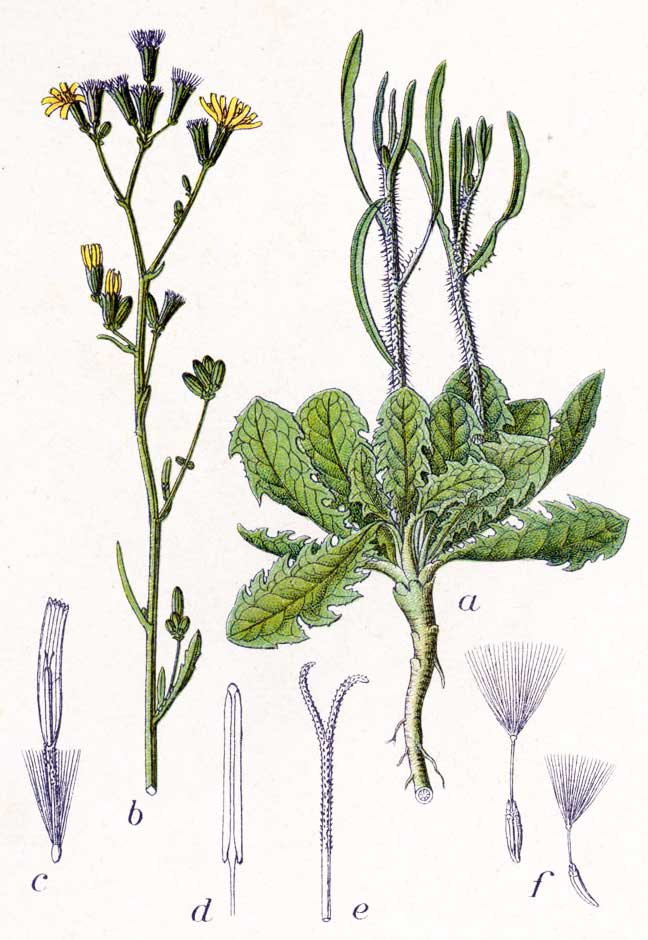
Chondrilla juncea
Classification System: APG IV
Superregnum: Eukaryota
Regnum: Plantae
Cladus: Angiosperms
Cladus: Eudicots
Cladus: Core eudicots
Cladus: Asterids
Cladus: Campanulids
Ordo: Asterales
Familia: Asteraceae
Subfamilia: Cichorioideae
Tribus: Cichorieae
Subtribus: Chondrillinae
Genus: Chondrilla
Species: Chondrilla juncea
Varietas: C. j. var. longifolia
Name
Chondrilla juncea L.
Synonyms
Chondrilla acantholepis Boiss.
Chondrilla acanthophylla Borckh. ex Rchb.
Chondrilla angustissima Hegetschw.
Chondrilla crepoides Reich.
Chondrilla gaudini Hegetschw.
Chondrilla glomerata C. Koch
Chondrilla hispida Desf.
Chondrilla intybacea Friv.
Chondrilla juncea subsp. acantholepis (Boiss.) Takht.
Chondrilla juncea subsp. macrocarpa J. Chrtek
Chondrilla laciniata Stev.
Chondrilla lutea Dulac
Chondrilla rigens Rchb.
Chondrilla viminea Bub.
Chondrilla virgata J. & C. Presl
Chondrilla viscosa Gilib.
Hieracium chondrilla E. H. L. Krause
Hieracium junceum Bernh.
Distribution
Native distribution areas:
Continental: Europe
Sweden, France, Andorra, Portugal, Spain, Baleares (Ibiza & Formentera, Mallorca, Menorca), Gibraltar, Netherlands, Belgium, Luxembourg, Germany, Switzerland, Austria, Italy, Corsica, Sardinia, Sicily, Poland, Czech Republic, Slovakia, Hungary, Slovenia, Croatia, Bosnia & Hercegovina, Serbia & Kosovo, Montenegro, Macedonia, Albania, Romania, Bulgaria, Greece (incl. Kiklades), Crete, East Aegaean Isl., Rhodos, European Turkey, Latvia, Belarus, Moldova, Ukraine, Crimea, C-, E- & S-European Russia (incl. Kaliningrad region)
Continental: Africa
Morocco, Algeria, Tunisia, Libya, Canary Isl. (Tenerife)
Continental: Asie
Northern Caucasus, Georgia [Caucasus], Armenia, Azerbaijan (incl. Nachichevan), Kazakhstan, Turkmenistan, Uzbekistan, Argentina (introduced), Turkey (E-Anatolia, Inner Anatolia, N-Anatolia, NE-Anatolia, NW-Anatolia: Bithynia, S-Anatolia, SE-Anatolia, SSW-Anatolia, W-Anatolia), Cyprus (C-Mountains, N-Cyprus, W-Cyprus), European Turkey, Iran (EC-Iran, NE-Iran: Mts., N-Iran, Iranian Aserbaijan, W-Iran), Iraq (NE-Iraq, NW-Iraq), Israel (coastal W-Israel, Rift Valley, N-Israel), Lebanon (Antilebanon, C-Lebanon, coastal W-Lebanon), Saudi Arabia (Hejaz), Saudi Arabia (Asir), Syria (Jbel Druze, W-Syrian Mountains), Afghanistan (Herat)
References: Brummitt, R.K. 2001. TDWG – World Geographical Scheme for Recording Plant Distributions, 2nd Edition
References
Linnaeus, C. 1753. Species Plantarum. Tomus II: 796. Reference page.
Links
Hassler, M. 2018. Chondrilla juncea. World Plants: Synonymic Checklists of the Vascular Plants of the World In: Roskovh, Y., Abucay, L., Orrell, T., Nicolson, D., Bailly, N., Kirk, P., Bourgoin, T., DeWalt, R.E., Decock, W., De Wever, A., Nieukerken, E. van, Zarucchi, J. & Penev, L., eds. 2018. Species 2000 & ITIS Catalogue of Life. Published online. Accessed: 2018 May 20. Reference page.
International Plant Names Index. 2018. Chondrilla juncea. Published online. Accessed: May 20 2018.
The Plant List 2013. Chondrilla juncea in The Plant List Version 1.1. Published online. Accessed: 2018 May 20.
Tropicos.org 2018. Chondrilla juncea. Missouri Botanical Garden. Published online. Accessed: 20 May 2018.
USDA, ARS, Germplasm Resources Information Network. Chondrilla juncea in the Germplasm Resources Information Network (GRIN), U.S. Department of Agriculture Agricultural Research Service. Accessed: 07-Oct-06.
Vernacular names
Deutsch: Binsen-Knorpelsalat
English: Rush skeletonweed
español: Ajonjera
suomi: Isopiiskasalaatti
հայերեն: Խիժաճարճատուկ կնյոնանման
vèneto: Crencanèla
Chondrilla juncea is a species of flowering plant in the family Asteraceae known by a number of common names, including rush skeletonweed, gum succory, devil's grass, and nakedweed. The plant is native to Europe, Asia, and North Africa, but it is known throughout most temperate regions of the world as an introduced species which is usually considered a noxious weed.
Description
It is a thin, spindly plant which reaches a meter in height. It starts from a basal rosette of leaves and branches extensively, often forming a weedy thicket. It produces small daisy-like flowers with rectangular yellow ray florets. The fruit is an achene about a centimeter long topped with a white pappus. It reproduces by seed but also by cloning itself at the root; tilling of soil and chopping up plants actually help this species disperse by sectioning and distributing root parts.
Distribution
Native
From the Aral Sea area in Kazakhstan and Uzbekistan in Central Asia, westward through Russia, through Europe, to Portugal; and southward through the Caucasus and Southwest Asia, and west to North Africa.[2][3][4]
Introduced
North America, earlier only on the East Coast, but by the 1960s reaching Washington, Oregon, and northern California. Weed in Eastern Australia.[2][3][4]
Weed risk
This plant is considered a very troublesome weed in many areas. It easily invades fields, clogs harvesting machines, and successfully competes with other plants for water. There are several biological control measures used against this plant. The skeletonweed gall midge (Cystiphora schmidti - an insect), the skeletonweed gall mite (Aceria chondrillae - an arachnid), and skeletonweed rust (Puccinia chondrillina - a rust fungus of Chondrilla)[2][3] all show potential for controlling infestations.
Uses
In the Greek island of Crete the leaves and the tender shoots of a local variety called ampelosyrida (αμπελοσυρίδα) or glykosyrida (γλυκοσυρίδα) are eaten raw or boiled in salads by the locals. The plant is also traditionally consumed by ethnic Albanians (Arbëreshë) in the Vulture area (southern Italy). Chondrilla juncea may have an anti-oxidant activity and some potential for medicinal use. XO-inhibiting activity shown by extracts of the aerial parts of the plant with potential benefits for hyperuricaemia and gout.
References
"Chondrilla acantholepis Boiss. | Plants of the World Online | Kew Science". Plants of the World Online. Retrieved 21 August 2022.
HASAN, S.; WAPSHERE, A. J. (1973). "The biology of Puccinia chondrillina a potential biological control agent of skeleton weed". Annals of Applied Biology. Association of Applied Biologists (Wiley-Blackwell). 74 (3): 325–332. doi:10.1111/j.1744-7348.1973.tb07753.x. ISSN 0003-4746.
Te Beest, D. O.; Yang, X. B.; Cisar, C. R. (1992). "The Status of Biological Control of Weeds with Fungal Pathogens". Annual Review of Phytopathology. Annual Reviews. 30 (1): 637–657. doi:10.1146/annurev.py.30.090192.003225. ISSN 0066-4286. PMID 18647103.
"Rush Skeletonweed (Chondrilla juncea)". iNaturalist. Retrieved 2021-04-21.
Retrieved from "http://en.wikipedia.org/"
All text is available under the terms of the GNU Free Documentation License

